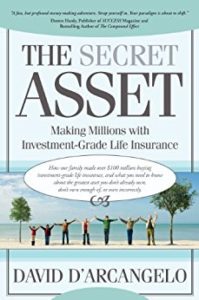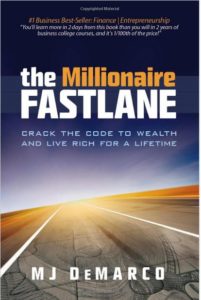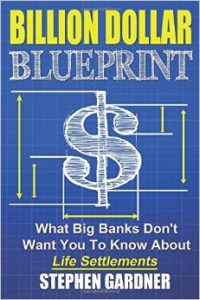Money, Wealth, Life Insurance: How the Wealthy Use Life Insurance as a Tax-Free Personal Bank to Supercharge Their Savings is a concise and well written book that gives all the basics of Infinite Banking. It’s simply straight-forward – and I love that. The examples are easy to follow and the chapters are pretty thin on the marketing fluff – a huge bonus. It doesn’t go into great depth in any one area, but Jake Thompson finishes the book off with a handful of case studies that make a strong argument for High Cash Value Life Insurance.
Life Insurance is Incredibly Safe
For those unfamiliar with using life insurance as an alternative retirement savings tool, Thompson starts the book off by addressing the risk associated with various savings methods. And one of the tools that he uses to measure the various savings methods, is what he calls the “greatest test of all” – the test of time. Thompson has this to say about it:
“It will literally save thousands of individuals, families, and businesses from financial ruin and devastation. It will be a beacon of hope in the midst of chaos. And most importantly, it will be a source of stability and control in an industry full of crooks and criminals, willing to do anything to make an extra buck.”
Because Thompson believes so strongly in the test of time, he uses it as a measuring stick for the various savings methods of the last century. Life insurance comes out on top, and all the others perform poorly by comparison. Thompson states that in October of 1929 the stock market plunged 22% in just a few days. And within a few years, by 1932, it would lose roughly 90% of it’s peak value.
“Over 40% of banks would shutdown. Millions of savings accounts would simply disappear. Here’s where it gets interesting…”
But Thompson goes on to say that something interesting was happening in the financial industry during that whole collapse.
“While banks, businesses, and government sectors were closing their doors, one sector of the economy stood strong and steady, unaffected by these horrible circumstances. Life insurance companies. Life insurance companies remained virtually unscathed. While the markets suffered severe losses, owners of cash value life insurance didn’t lose a dime. They didn’t lose any money in the Great Depression, and they haven’t lost money since.”
Thompson also discusses how people like J.C. Penny and Walt Disney managed to navigate the troubled waters of the Great Depression, with the help of cash value life insurance. The argument is clearly taken that cash value life insurance is about as safe a place as possible for saving.
This safety factor, according to Thompson, is the key factor that entices Banks and Corporations to jump on the life insurance train. He says they even have a special name for the train, it’s called Bank-Owned Life Insurance (BOLI) and Corporate Owned Life Insurance (COLI).
Thompson gives the following numbers to show just how much is owned by the big banks in America:
Bank Owned Life Insurance Assets
Bank of America: $19,607,000,000
Wells Fargo Bank: $17,739,000,000
JPMorgan Chase Bank: $10,327,000,000
U.S. Bank: $5,451,892,000
“For banks, it provides the ultimate in safety, stability, and growth. More importantly, the FDIC allows this asset to be classified as Tier 1 capital, which is the safest capital a bank can have. Tier 1 capital is considered to be the core measure of a bank’s financial strength.”
So why isn’t everyone jumping on the same train?
Lies on Wall Street
If you were born after 1960, you probably grew up believing that everyone that was saving for retirement was using some form of qualified retirement plan. 401k scam plans and IRA’s seemed to be a part of every major company. But here is the deal – it hasn’t always been that way. In fact, as Thompson points out, during the 1900’s estimates show that over 50% of all savings went into cash value life insurance of some kind.
“It was the staple for safety, protection, and predictable future income for decades. It’s only been in the last few decades that people have fallen prey to a contrarian belief.”
Wall Street firms were the groups primarily pushing the new legislation in America that would encourage companies to invest in their mutual fund products – namely, the 401k and other qualified plans. Companies were excited about these plans because it typically meant that they could offer more options to employees, without having to add additional expense. And in some cases, the costly administration of pensions was eliminated altogether.
By transitioning money from the safety and guarantees of a cash value life insurance policy to risk in the stock market, Wall Street firms stood to gain a lot. And they did. In fact, since the advent of the 401k and other government plans, the stock market has nearly quadrupled in total assets. This was a huge gain for Wall Street firms and advisors, but a huge loss for Americans.
Thompson lost his shirt in the stock market. He says that for nearly 11 years he participated in mutual funds just like an average investor. During that time, he ended up with less money than he had put in. So he changed his philosophy.
Old Philosophy: Do what everyone else is doing.
Result: Lost money.
New Philosophy: Don’t lose money.
Result: Money gained.
Thompson shares that during the 2008 financial crisis that everyone said was the worst since the Great Depression, he never lost money. In fact, he says he ended up using his cash value life insurance to invest in two real estate properties. Within 3 years he had made back his entire investment in rental income alone, and the properties were still increasing in value.
THE ULTIMATE FREE DOWNLOAD
The Self Banking Blueprint
A Modern Approach To The Infinite Banking Concept

Tax-Free
Money, Wealth, Life Insurance also explains what Thompson calls – the 401k predicament. This predicament is what every investor faces today if they are considering a qualified (tax-deferred) plan. Will you be in a lower tax bracket when you retire, or will you be in a higher tax bracket?
The mutual fund peddlers are quick to say that you’ll be making less money, you won’t have a large taxable income, and that you’ll likely gain more if you defer taxes. However, they don’t know what the future holds. And what’s worse, if they actually are as successful as they hope to be with your money, you might be in a higher tax bracket with fewer write-offs.
Thompson says that what worked in the 70’s and 80’s isn’t working today, because back then tax brackets were intended to be lower in retirement – not so anymore. Here’s a few quotes from CPA’s that were interviewed regarding this issue:
“I’m seeing them retire with very few deductions and if they’ve been socking it away in 401ks or just tax deferred plans, I see them retiring with very few deductions and 100% taxable income.” – Kevin CPA
“I see it all the time with people who’ve created wealth, and done the right things with their money throughout their life. By the time they retire they’re actually making more money than they did when they were working.” – Cameron CPA
Risk
Thomson says that there are two types of risk in his opinion. Smart risk, and Dumb risk.
“Smart risk is simple. It’s calculated risk. You understand why you are taking it and you see the potential gains for risk well taken. This doesn’t always go your way, but that’s okay, you knew what you were in for.”
The dumb risk is when you invest in a 401k because everyone else is doing it and it seemed like the thing to do. It’s not knowing anything about the companies you’re investing in, and yet giving them money every month. That type of risk is dumb and speculative. Essentially you’re just gambling.
People frequently refer to Warren Buffet as a highly successful man that invests in the stock market. But it’s different with Buffet according to Thompson.
“For Mr. Buffett, buying a stock is buying a company. He knows the company, he calculates the risk, sees the potential, and pulls the trigger. The vast majority of Americans are mindlessly tossing money into the market, hoping something good will come of it. One is smart risk, the other is dumb risk.”
Case Studies and Banking
Thompson finishes the book off with some excellent data for those that really want to see the numbers. The book is well worth the read if for no other reason that to browse his data. As a sampling let me share a couple studies:
“A case study by Mass Mutual Life Insurance Company showed the performance of 3 policies from 1980-2013. The internal rate of return for each of these policies were 5.65%, 6.02%, and 6.22%.”
Another:
“According to Crestmont Research, the S&P 500 earned actual returns (before management fees and taxes) of 0% in the last 5 years and 2% in the last 10 years. You’ll have to go back 20 years to hit a high of 7% annual returns.”
He points out that most people in the stock market don’t even get the average return of the S&P 500. Typically they do worse. And yet if you own a life insurance policy and get returns of around 6%, because of the tax benefits, this return is actually equivalent to around 8.6% annually. And don’t forget that there are fees associated with your qualified accounts in many cases. Even if you managed to match the 8.6% return of the life insurance policy, you’d still have to pay fees. AND you still have to buy life insurance to be comparable.
Can you expect to make a 10% market return every year from now until retirement? Thomson knows that you will say “no.”
Thompson spends a little time in the book discussing the difference between a policy withdrawal on your life insurance and a policy loan. He stresses that life insurance policy loans are an excellent tax and savings strategy, and he talks about the ability to gain through arbitrage as well.
Finally, Thomson stresses that the real power of high cash value life insurance is actually in the ability to use the money like a bank. He mentions infinite banking, and talks about the process of using the easily accessible cash value of your policy to fund a variety of investments, while also earning money in the form of dividends from a mutual insurance company.
If you’re new to the banking concept of life insurance, or even if you just want to know a little more about cash value life insurance, pick up a copy of Money, Wealth, Life Insurance, by Jake Thompson. Those of us at I&E are always anxious to read good books on our favorite financial subject, and we hope this review has shed some light on it at well. If you want to talk about cash value life insurance and see how it might fit into your savings goals, contact us for a free evaluation.
THE ULTIMATE FREE DOWNLOAD
The Self Banking Blueprint
A Modern Approach To The Infinite Banking Concept





